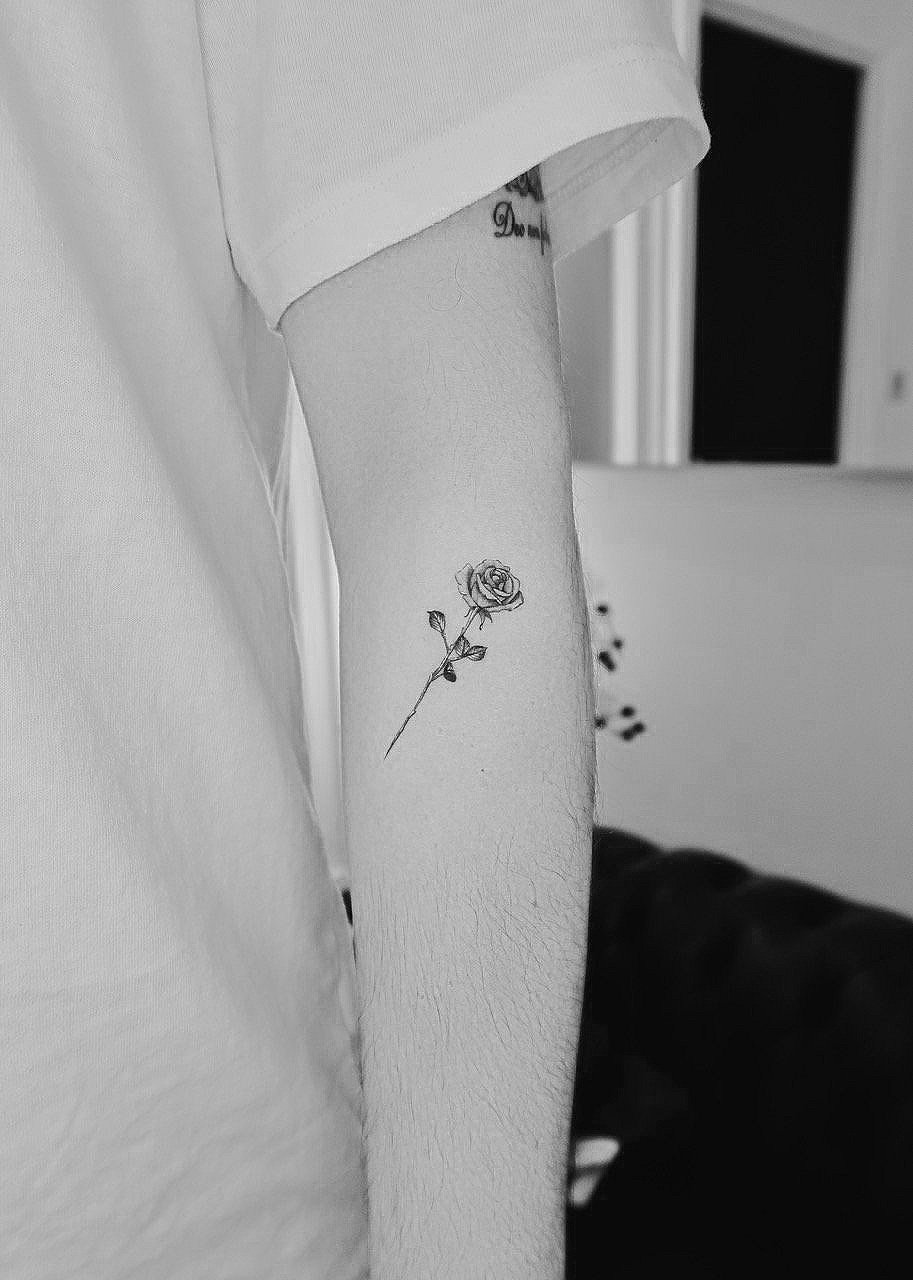Fine line tattoos healing is a delicate process that requires patience, proper aftercare, and a deep understanding of the art itself. Whether you're an enthusiast or a professional tattoo artist, knowing how to care for these intricate designs is essential. Fine line tattoos, known for their elegance and precision, demand special attention during the healing phase to ensure they retain their beauty and clarity. This guide will walk you through every step of the healing process, offering expert tips and advice to help you achieve the best results.
As the popularity of fine line tattoos continues to rise, so does the importance of proper healing techniques. Unlike bold or larger tattoos, fine line tattoos are more susceptible to fading, smudging, or losing detail if not cared for properly. This makes it crucial for both clients and artists to understand the nuances of the healing process. In this article, we will explore the science behind tattoo healing, provide step-by-step aftercare instructions, and address common concerns that may arise during this critical period.
Our goal is to empower you with the knowledge and tools necessary to ensure your fine line tattoo heals beautifully. From understanding the healing timeline to troubleshooting potential issues, this guide covers everything you need to know. Whether you're a first-time tattoo recipient or someone looking to expand their knowledge, this article will provide valuable insights to help you achieve the best possible outcome for your fine line tattoo.
Read also:Roberts Field Airport Redmond Your Gateway To Central Oregon
What Is the Importance of Proper Fine Line Tattoos Healing?
Proper fine line tattoos healing is not just about ensuring your tattoo looks good—it's about maintaining its integrity and longevity. Fine line tattoos are designed to be delicate and precise, which means they require a more meticulous approach during the healing phase. Unlike other tattoo styles, fine line tattoos can easily lose their definition if exposed to improper care. This makes it vital to follow a structured healing routine and avoid common pitfalls that could compromise the quality of your tattoo.
The healing process typically lasts between two to four weeks, depending on factors like skin type, environmental conditions, and personal hygiene practices. During this time, your skin undergoes several stages of healing, including initial inflammation, scabbing, and peeling. Each stage requires specific care to prevent complications such as infection or ink loss. By understanding these stages and adhering to proper aftercare, you can ensure your fine line tattoo retains its beauty for years to come.
How Can You Tell If Your Fine Line Tattoos Healing Properly?
Monitoring the healing process of your fine line tattoo is crucial to identify any issues early on. Signs of proper healing include mild redness, slight swelling, and the formation of a thin layer of scabs. As the tattoo progresses through its healing stages, you may notice peeling or flaking, which is normal. However, if you observe excessive redness, pus, or persistent pain, it could indicate an infection or improper healing. In such cases, consulting a professional tattoo artist or dermatologist is recommended.
To ensure your fine line tattoos healing proceeds smoothly, it's important to keep the area clean and moisturized. Avoid picking at scabs or exposing the tattoo to harsh chemicals, as these actions can lead to scarring or ink loss. By staying vigilant and following aftercare instructions, you can minimize the risk of complications and achieve optimal healing results.
Why Is Aftercare Essential for Fine Line Tattoos Healing?
Aftercare plays a pivotal role in the healing process of fine line tattoos. Without proper care, even the most beautifully executed tattoo can lose its vibrancy and detail. Aftercare involves a combination of hygiene practices, moisturizing routines, and lifestyle adjustments to support the healing process. For instance, avoiding direct sunlight and using sunscreen can help protect your tattoo from fading, while staying hydrated and eating a balanced diet can promote skin health.
Many people underestimate the importance of aftercare, leading to suboptimal healing outcomes. To avoid this, it's essential to follow a structured routine tailored specifically for fine line tattoos. This includes cleaning the tattoo with a gentle soap, applying a recommended moisturizer, and avoiding activities that could irritate the skin, such as swimming or excessive sweating. By prioritizing aftercare, you can ensure your fine line tattoo heals properly and retains its intended design.
Read also:When Was Michael Jordan Died Unveiling The Truth Behind The Legend
What Are the Common Mistakes During Fine Line Tattoos Healing?
While the healing process may seem straightforward, there are several common mistakes that can hinder the recovery of your fine line tattoo. One of the most frequent errors is over-moisturizing, which can cause the tattoo to become too soft and blur the lines. Another mistake is neglecting to keep the tattoo clean, which increases the risk of infection. Additionally, exposing the tattoo to water for extended periods, such as during showers or baths, can lead to ink loss and smudging.
Other common pitfalls include picking at scabs, using unsuitable products, and failing to protect the tattoo from UV rays. Each of these actions can compromise the healing process and affect the final appearance of your fine line tattoo. By being aware of these potential mistakes and taking steps to avoid them, you can ensure your tattoo heals correctly and maintains its intended beauty.
How Long Does Fine Line Tattoos Healing Take?
The duration of the fine line tattoos healing process can vary depending on several factors, including the size and complexity of the tattoo, as well as individual skin types. On average, the initial healing phase lasts two to four weeks, during which the tattoo goes through stages of inflammation, scabbing, and peeling. However, it can take up to six months for the tattoo to fully settle and reach its final appearance.
During the first two weeks, it's crucial to focus on keeping the tattoo clean and moisturized while avoiding activities that could irritate the skin. As the healing progresses, you may notice the colors becoming more vibrant and the lines sharper. It's important to remember that everyone's healing process is unique, so patience and consistency are key to achieving the best results.
What Products Are Best for Fine Line Tattoos Healing?
Choosing the right products for fine line tattoos healing is essential to ensure proper care and optimal results. Many tattoo artists recommend using a fragrance-free, hypoallergenic moisturizer specifically formulated for tattoo aftercare. These products are designed to hydrate the skin without causing irritation or interfering with the healing process. Popular options include Aquaphor, Tattoo Goo, and Hustle Butter, all of which are widely regarded for their effectiveness.
In addition to moisturizers, it's important to use a gentle soap to clean the tattoo. Avoid using harsh chemicals or exfoliating products, as these can damage the delicate skin and cause ink loss. For added protection, applying sunscreen with an SPF of 30 or higher can help shield your tattoo from UV rays, preserving its color and vibrancy over time.
What Are the Stages of Fine Line Tattoos Healing?
The fine line tattoos healing process consists of several distinct stages, each requiring specific care and attention. The first stage, inflammation, occurs immediately after the tattoo is applied and typically lasts for the first few days. During this time, the tattooed area may appear red and swollen, and it's important to keep it clean and dry to prevent infection. Applying a thin layer of moisturizer can help soothe the skin and promote healing.
The second stage, scabbing, usually begins around day three and lasts for about a week. During this phase, the tattoo may develop a thin layer of scabs, which should be left alone to fall off naturally. Picking at scabs can cause ink loss and scarring, so it's crucial to resist the temptation. The final stage, peeling, occurs as the skin begins to shed its outer layer, revealing the healed tattoo beneath. This stage can last up to two weeks and requires continued moisturizing to ensure the tattoo remains smooth and vibrant.
Can Fine Line Tattoos Healing Be Accelerated?
While it's natural to want your fine line tattoos healing process to proceed quickly, it's important to remember that rushing the healing can lead to complications. However, there are steps you can take to support the natural healing process and potentially speed up recovery. For instance, maintaining a healthy diet rich in vitamins and minerals can promote skin health and accelerate healing. Drinking plenty of water also helps keep the skin hydrated, which is essential for proper recovery.
In addition to dietary changes, avoiding activities that could irritate the tattoo, such as smoking or excessive physical exertion, can help facilitate healing. Using high-quality aftercare products and following your artist's recommendations can also contribute to faster recovery. While these steps may not dramatically shorten the healing timeline, they can help ensure a smoother and more efficient process.
What Should You Avoid During Fine Line Tattoos Healing?
During the fine line tattoos healing process, there are several activities and habits you should avoid to prevent complications. First and foremost, avoid exposing your tattoo to direct sunlight or tanning beds, as UV rays can fade the ink and damage the skin. Additionally, steer clear of swimming pools, hot tubs, and saunas, as the chlorine and heat can irritate the tattoo and prolong healing.
Other activities to avoid include scratching or picking at scabs, using harsh soaps or lotions, and engaging in strenuous physical activities that cause excessive sweating. These actions can interfere with the healing process and lead to complications such as infection or ink loss. By being mindful of these potential pitfalls and taking precautions, you can ensure your fine line tattoo heals properly and retains its intended beauty.
Conclusion: Embrace the Journey of Fine Line Tattoos Healing
Fine line tattoos healing is a journey that requires patience, dedication, and proper care. By understanding the stages of healing, avoiding common mistakes, and following expert advice, you can ensure your tattoo heals beautifully and retains its intended design. Remember, the healing process is just as important as the tattoo itself, and taking the time to care for your skin will pay off in the long run. So embrace the journey, trust the process, and enjoy the results of your fine line tattoo.
Table of Contents
- What Is the Importance of Proper Fine Line Tattoos Healing?
- How Can You Tell If Your Fine Line Tattoos Healing Properly?
- Why Is Aftercare Essential for Fine Line Tattoos Healing?
- What Are the Common Mistakes During Fine Line Tattoos Healing?
- How Long Does Fine Line Tattoos Healing Take?
- What Products Are Best for Fine Line Tattoos Healing?
- What Are the Stages of Fine Line Tattoos Healing?
- Can Fine Line Tattoos Healing Be Accelerated?
- What Should You Avoid During Fine Line Tattoos Healing?
- Conclusion: Embrace the Journey of Fine Line Tattoos Healing


